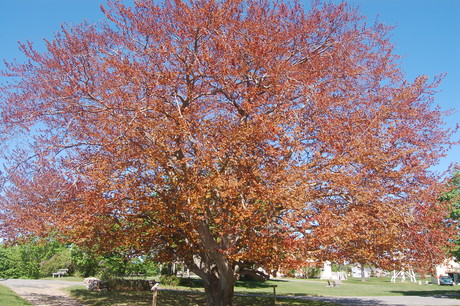The Wrack
The Wrack is the Wells Reserve blog, our collective logbook on the web.
The Wrack is the Wells Reserve blog, our collective logbook on the web.

The following was published in the Biddeford-Saco Journal Tribune Sunday edition, 9/22/13 [the fall equinox]:
This week the Wells Reserve at Laudholm is abuzz with preparations for our annual Punkinfiddle Family Festival, a rite of fall for this old New England farm. It’s our last big event of The Busy Season, and it always makes the fourth week of September feel like a “the turning point” – exit summer, enter fall. Frost threatens, jackets are located, the kids are ensconced once more in school. Water toys and pleasure craft are tucked away with the rest of summer’s memories; winter is coming and it’s time to pull back.
For the trees here at the Reserve, festive summer is nearly over too. Starting today, the sun will peak lower in the sky each day until the December solstice. Less sunlight plus more cold equals changing leaves. Summer’s energy is literally waning, and that means death for leaves, and their reliable mourning glory.
As always with nature, there’s more to the glory than meets the eye.
A quick review: chlorophyll is the substance all plants use to turn sunlight and [ever-increasing] carbon dioxide into energy and structure. A fortunate byproduct of this photosynthetic process is oxygen, which we humans really can’t live without.
In the northern hemisphere, the cooler and shorter days of fall trigger an end to leaves’ production of auxin, a hormone that during the growing season keeps each leaf’s circulatory system open. Auxin’s cessation allows a layer of cells in the leaf stem to dam the circulation of water and nutrients to the leaf. With no circulation, chlorophyll disintegrates, allowing yellow carotene to appear. The yellows of fall are already there, even in summer; they’re just hidden by the deep green of chlorophyll.
Autumn reds arrive by a different process: anthocyanin, a completely new substance, is created by cold-induced chemical changes in leaves. The jury is still out on what purpose(s) anthocyanin serves, but at least one theory is worth noting here for its geographic peculiarity.
In Europe, autumn leaves are mostly yellow, while the United States boasts far more red foliage. Recent research has found that aphids are attracted to yellow leaves; anthocyanin’s red may serve as a way for some trees to continue making sugars in autumn while deterring pests. Over the past 35 million years in North America, the Appalachians and Rockies, running north-south, allowed glaciers to come and go; Europe’s Alps, running east-west, did not allow as much interplay. So European trees and pests settled into an earlier détente, while between ice ages here, trees and the pests that plague them competed more often, thus evolving more varied tactics. Maple red may be one.
Our glorious multicolored New England fall, perhaps originally a fluke of prehistoric geology, still depends on dwindling sunlight and cooler nighttime temperatures. The sun is reliable, but the climate nowadays? Not as much. In a warming world, our future nights won’t be as cool. What will happen then to our fall foliage? Another “turning point,” merely hundreds of years in the making, may be coming.
Nik Charov is president of Laudholm Trust, the nonprofit partner of the Wells National Estuarine Research Reserve in Wells, Maine. His Sunday Journal Tribune column, “Between Two Worlds,” ventures forth from the intersection of art and science, past and future, leaf and branch. More at wellsreserve.org/twoworlds.